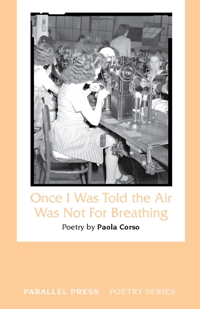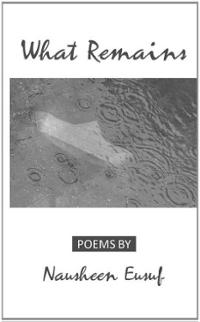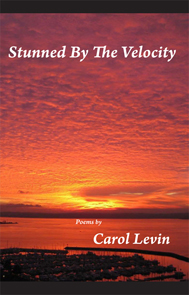Book Review
- Paola Corso, Once I Was Told the Air Was Not for Breathing, Parallel Press, 2012
- Nausheen Eusuf. What Remains, Longleaf Press, 2011
- Carol Levin, Stunned By The Velocity, Pecan Grove Press, 2012
by Margaret Rozga
My mother loved history. I inherited that love. As a poet, I want to bring the power of poetry to significant stories from the past. As a reader of poetry, I look for poetry that engages with history in order to learn both the content and the strategies for making that content come alive. In their recent books, Paolo Corso, Nausheen Eusuf and Carol Levin offer a wonderful array of strategies and insights into the ways that poetry and history can work together to the benefit of both. History provides rich content for poetry; poetry keeps the history alive.
In Once I Was told the Air Was Not for Breathing, Paola Corso writes deeply moving poems about working-class men and women who once faced and still face hazardous conditions in their work places, including the Triangle Shirtwaist Factory, site of the infamous 1911 fire that killed 146 workers. She draws on historic documents and provides both footnotes and endnotes to connect the poems to actual events. This meticulous academic framework contrasts the gritty details of the workers’ lives as the poems give voice to stories mostly forgotten.
Well-chosen details about the effects of work in steel mills and garment factories relentlessly convey a sense of each person’s struggle to survive. The poems put us in specific work places with specific workers facing specific physical dangers and losses. The worker whose story is told in “Barely One Hundred Fifty Pounds Man” loses his hair (19), watches “men younger than him sicken with cancer” and finally after twenty years quits to read the Bible and become a minister because “he already knows everything there is to know about hell” (20).
In “Diary of a Furnace Worker Cleaning Number Seven” the speaker describes his job. The generally plain-spoken language gains a crisp and direct emotional power as it builds toward the metaphor of lungs burning like paper.
I unscrew the trap on top of the stove,
drop the ladder and climb down
with teapot lamp and rod to poke out
flue-dust clogged in the checkerwork.Some of the dust is wet and caked, some is light
and settles on my shoulders or flies in my nose.
I blow through my nostrils to keep it out.
Flames seem to go in with my breath.My lungs are paper on fire. I poke fast. (18)
More abstract, and clichéd, language is found in official circles like the Coke Oven Advisory Committee whose meeting is recorded in “Above Zero.” Any coke oven emissions above zero will mean shorter life spans for workers. Unwilling to set the standard at zero, the chairwoman says “Society has to come up with levels that// we are willing to live with” (22). The line spacing signifies her long breath pause and suggests distance and a terrible irony: her “we” is not the same as the workers’ “we.”
There are a few glimpses of personal and family life like quick gulps of air. There are mothers “bleaching curtains” and a father telling a son “he better learn/to use his head and not his hands” (25). Most of these are memories of children who as adults escaped factory work, but for the workers themselves, many of them immigrants, the world of work dominates and threatens to obliterate personal and family life.
These poems insist we recognize that what was true in the early twentieth century remains true in the present. In the ironically titled “Girl Talk,” arguably the book’s most compelling poem, the girl talk is not of dates, movies, friends, and fashion. It is of ongoing oppressive work conditions, and it takes place imaginatively between the women of the Triangle Shirtwaist Factory and “the Chinese girls, the Indonesian girls,/the Vietnamese girls, the Taiwanese girls” making Nikes. It builds through a refrain of gluing their work conditions to a part “of the shoe” and ends with a call to resistance:
take the vertigo, headaches, vomiting,
memory loss, shortness of breath, the cancer
and glue it to the glue of the shoetake the glue glue toxic glue
And put it under his nose, a Nike nose
An anything-goes nose and make him sniff (35)
In poem after poem here, the workplace conditions are such that they literally and metaphorically cut short the workers’ ability to breathe. The alliteration and quick rhyme in this poem might in another context sound playful; here those sound effects contrast the dire factory conditions. By virtue of such contrasts , Corso gives voice to stories that need to be remembered if working people are ever to find work that allows them a fullness of breath and life.
The spare poems in Nausheen Eusuf’s What Remains place a family story at center. If they present history, it is family history. In particular, they present a story of grief: the husband grieving his wife, the daughter grieving her mother. The husband and father’s emotions as the wife and mother struggles through her last days are recounted in “The Dialysis Room” where he watched “her dark red blood swirl and flow/through delicate tracts of tubes to be cleansed” (11). His care for her is gentle, coming from a place of deep attachment in contrast to the “cordial” but more detached care she receives from the hospital staff. His actions and emotions are described in quatrains with rhyme in the second and fourth lines, a choice that captures well both the feeling of his connection to his wife and his feeling of being unsettled by her illness and imminent death.
Leaving the hospital , he’d always feel
dizzy, his senses ravaged by the sway
of the crowd, the ceaseless flow
of traffic, the blinding light of the day. (11)
The daughter’s grief, too, finds in formal poetry some of its most poignant expression as in “Sestina” where the repeated words are whisper, know, mother, child, aunts, and watch. Images of rain abound in the scenes the daughter recalls, both the gentle rain she loved to play in as a child and the violent kal-baishakhi storms of the Bengali region of the Indian subcontinent. She associates both with her mother, warnings of catching pneumonia in the rain “sweet as rice pudding” and calming of her fears of the storms. Small details cause flare-ups of her grief: “her glasses, perched so casually/on the TV where she left them last,/her toothbrush in the bathroom” (13). Most of all, the daughter recalls memories of her mother’s warmth.
I’d trace the dark blue veins
On the back of your hand—
the skin loose, wrinled
but soft, like rice cakes,
and warm, like when
you’d make room for me
on your side of the bed (3)
This family story also reaches beyond its immediate setting. It is a story that spans two continents and touches several generations. It hints at the American immigrant narrative with some significant differences. The daughter, whose adult life is American, retains rather than loses her roots in Bengali. Her American life does not follow the pattern of rising from poverty into the middle class. Her mother, too, pursued an academic career we learn as the daughter refers to “the front lawn/of the building where she taught for thirty years” (13).
The large life events of the daughter’s academic achievements and move to another continent appear as they are relevant to the story of loss and grief and what remains. They seem incidental details: a plane landing (12) or a phone ringing: “It’s his daughter, from America” (15). World events intrude into the father’s grief after his wife’s death when suffering from sleeplessness, he “flips on the TV:/ more dead in Iraq” (15). Even in their focus on the abiding family love that remains through the grief, they also show that family in the context of the world. The father may be lonelier because the daughter seeks a new opportunities away from home.
For a poet like me, living with her own mother’s love of history, these elegant poems suggest that individual stories may be inextricable from larger movements of history.
Given the emphasis in this review on the individual in history, one of the subtle and most interesting features of Carol Levin’s Stunned by Velocity is that the personal “I” emerges more strongly in a clearly defined historical context. Levin’s three-section book first presents the shadowy story of Serena Karina. In its bare outline, this is the story of a young American woman who on a trip to Greece is kidnapped and confined to a convent-like building by a woman who sets herself up as an abbess. Levin uses staccato-like lines to convey the startling turn of events.
Serena is
stunned by the velocitythat jigs her
to an unexpected
vacuum in an anteroom
of a convent
smacking
its brass bound gates’ giant
wooden lips
with a solid thump (5)
Her fiancé attempts to rescue her. He flies “across the world groomed in a Superman suit under his rucksack” (11). As his plan unfolds, it is “the real deal, Lone Ranger rescues/the damsel-in-distress plan” (18), elaborate, mock heroic and complicated with “black habits of nuns for all the guys to wear/evading the round-the-clock guard’s/military binoculars aligned for field use” (18).
But he is too late. Kept near starving, Serena Karina no longer has the power to resist and accepts the view of the would-be abbess and self-declared god Katingo Patares as her protector from the evils of the world and of men. In this bizarre attempt to escape the contemporary world, an individual person is minimized, redefined as
an exquisite electrochemical entity
that can be disrupted by self-imposed
ceremonies of fasting
and rituals that withhold sleep (10)
Serena Karina, conditioned by her kidnappers to see the world as evil and her cell as a “haven,” spurns her rescuers, “wastes her chance for escape” (20). We never find out what happens to her.
Sections two and three of the book present poems set forty years after these events. A stronger “I” is the voice in most of these poems: “I tender a tale, believe it//or not,/of Karina, my lover’s fiancée” (59). A traveler with children, she identifies herself as “wise/now” and even earlier she was determined to make something of her life, so as she says, she “took drama into my own hands” (35). Active, alert, a keen observer, she
was a circus
a symphony,
a cotton candy
heartquake watching
your eyes, minding your arms’
blond fur (33)
She has a clear sense of place: Paris, Venice, San Francisco, Chicago, Athens. She also has a complex sense of time conveyed in compelling metaphors. It is a “bungee cord” (77), so that present and past have an elastic relation between them. Similarly she says,
Time
is reality’s accordion. Unexpectedly
wasted a lot and our hearts have very
long to-do lists (76)
Her notion of time acknowledges a front line role for historic events, especially those of the volume’s key year, 1968.
It was going to be a year
we were touched by
an explosion in culture
here and everywhere.
It was going to be routine
for students to burn
draft cards, flags,
old family ties,
some would take off
their clothes, let down
their hair, sing songs of revolution. (44-45)
Such history may be upsetting to set positions as the alternately indented lines seem to signal. Yet this book suggests that a life fully lived is a life that is lived with a sense of its historical context. An anachronistic attempt to recreate a medieval world is mock heroic and is best described with comically inflated, often abstract, titles: “Philosophy of Celestial Hierarchy”; “The Dream Girl Dreamed Her Lover Became a Skeleton Representing the Death of Her Soul”; “Titillating the Devil’s Pecuniary Interest”; “Homer Speaks of the Laws of Mortal Nature and The Abbess’s Daughter Replies.” The grandiose language, however, cannot cloak the torture and the tragedy of the loss of personal autonomy and power.
These three books show the past to be in major and minor ways intertwined with the present. Using a variety of poetic means, they show individual lives affecting and affected by larger social and historic events. They also show the ways that such a contextual view of the personal can be subject matter for poetry. I found in them encouragement and models for writing poetry that engages history something my mother helped place at the top of my heart’s “very long to-do lists.”
There’s much well-crafted poetry to be enjoyed in these works. Corso’s vivid detail and imagery, Eusuf’s effective use of traditional forms, and Levin’s compelling metaphors are among the qualities likely to please readers and to model how poetry can keep personal, cultural, and labor history alive.
Margaret (Peggy) Rozga has published two books of poetry, the award-winning volume about Milwaukee’s fair housing marches, Two Hundred Nights and One Day and a collection responding to her Army Reservist son’s deployments to Iraq and Afghanistan, Though I Haven’t Been to Baghdad. Inspired by her small garden, she is currently completing work on a new manuscript, Justice Freedom Herbs.




